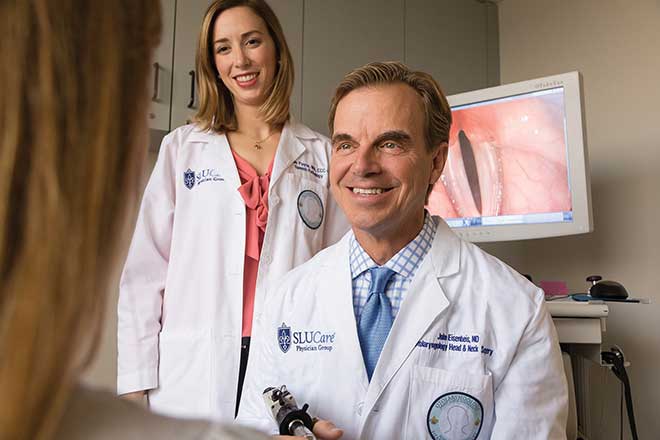When a friend calls, the ‘hello’ at the other end tells you who’s on the line. When you’re having a bad day, the voice of a loved one can soothe your worries. Some, like sports announcers, singers and radio hosts, count on their voices for their livelihood. So when Mary Eggleston, a music director at a local parish, noticed that her singing voice was giving her trouble, she became worried. “I would attempt to sing, and my voice would screech or do something goofy,” she says. “I knew it was something worse than a cold.”
Vocal cord disorders can be misdiagnosed for years, Eisenbeis says. One such condition is vocal cord dysfunction, in which the cords close abnormally during breathing, causing asthma-like symptoms. “Patients with this condition have learned bad breathing habits,” Eisenbeis explains. “Our speech-language pathologist works with them to retrain their brain, and the problem goes away.”
At the clinic, voice disorder patients first are given a stroboscopy, which allows physicians to see how the vocal cords are vibrating. “It’s useful to get in-depth knowledge about the patient and know what their vocal cords look like and how the architecture needs to change when they’re on the operating table,” Eisenbeis says. “It’s incredible to be able to treat these patients and use a picture of their vocal cords to help them understand what is going on.”
Mary Eggleston’s stroboscopy revealed a hemorrhaging polyp on her right cord, which was impeding it from vibrating properly. After she rested her voice to heal the hemorrhaging, she underwent surgery to remove the polyp. The procedure took only a few minutes, but completely fixed her voice, Eggleston reports happily. “I was barely even sore afterward,” she says. “It was scary thinking I could lose my singing voice. I’m thrilled to have it back—and it’s actually better than before.”
Eisenbeis loves working with the voice, he says, in part because it is so fundamental to who we are. “It’s such a unique signature, and if you heard anyone sing, from a little kid in a school play to the great Pavarotti, it’s amazing what we’re able to do with this instrument,” he says. “If someone loses their voice, it’s a significant impairment.”
The SLUCare Voice Disorder Clinic treats the full range of voice disorders. It is located at the Doctors Office Building at 3660 Vista Ave., Ste. 312, and Mercy Hospital at 621 S. New Ballas Road, Ste. 307A. Pictured on the cover, seated: laryngologist Dr. John Eisenbeis and nurse practitioner Sarah Keenan; standing: Speech-language pathologists Michelle Payne and Dr. Dennis Fuller, otolaryngology nurse Amy Marvin. For more information, call 314.251.6362 or visit slucare.edu/voice.
Pictured: Speech-language pathologist Michelle Payne and laryngologist Dr. John Eisenbeis
Cover design by Jon Fogel | Photos courtesy of SLUCare Physician Group
